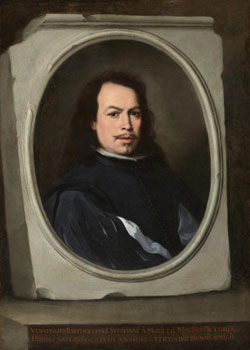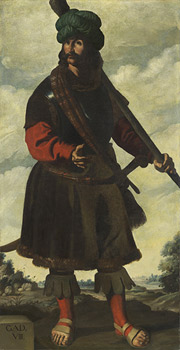Between Portraits and Genre
John Haberin New York City
Bartolomé Esteban Murillo: Portraits
Francisco de Zurbarán: Jacob and His Twelve Sons
Bartolomé Esteban Murillo was a portrait painter for today. History records just two self-portraits, but they point past his textbook works to his greatest strengths, in empathy and illusion. With their sentiment and bravura, his figures would look at home on social media. Meanwhile a contemporary in Seville, Francisco de Zurbarán, went so far as to destine his "Jacob and His Twelve Sons" for the new world.
Not that Murillo makes selfies. He takes no interest in where he was on a given day, and he sets himself apart from the crowd, as if literally set in stone. Yet his larger output has no shortage of sentiment and sickly smiles.  It runs to women and most especially children, dressed like urchins but basking in light. One little boy leans on a sill, but he might have stepped right out of the street. They seem no more important than what the artist and loved ones invest in them, but that is enough.
It runs to women and most especially children, dressed like urchins but basking in light. One little boy leans on a sill, but he might have stepped right out of the street. They seem no more important than what the artist and loved ones invest in them, but that is enough.
Murillo did not change all that much in twenty years, but he did grow into the role. Two paintings of other men show what he took as a model. He poses first as a self-styled aristocrat, like those men, with a goatee and mustache—just like his sitter. Shadows set his eyes off-kilter to bring out his bravura. He appears as an artist only in the illusion. He appears more explicitly as an artist later in life because he can no longer maintain the pretence of high society, but also because he no longer has to bother.
For all that, he did not often have time for portraits. The Spanish artist found a ready audience for religious paintings and genre scenes, with all their cherubs, ragamuffins, sweetness, and light—all a major influence on the late Baroque. With both portraiture and fiction, the Frick illuminates his practice of each—before turning on an even larger scale to Zurbarán. The show of Murillo, though, centers on those two known self-portraits, painted in the early 1650s and around 1670, from barely fifteen surviving portraits. They show him in his thirties, fashionable and confident, and again in his fifties, after the death of wife. They show him, too, staking out the image of the artist over the course of his life and the primacy of illusion in his art.
Set in stone
What if only two portraits of Rembrandt had survived, some twenty years apart? From more than a hundred self-portraits (counting prints and drawings as well as oils), one can trace Rembrandt's growth as an artist and his changing fortunes, but the differences would be starker still. One would see him as a young man, taking pride in his experiments with himself and vision. And then one would see an older Rembrandt, bankrupt and almost defeated, but every inch a painter and every inch a king. Nothing looks more regal than his work clothes and maul stick, which he used to steady his hands while painting—but which he wields like a scepter. And nothing better attests to the growing command of mass, light, layering, and impasto.
Self-portraits by Bartolomé Esteban Murillo seem far more of a piece—the first a gift to the Frick from Henry Clay Frick's descendants in 2014, the second from the National Gallery in London. He has much the same dark cloak and rippling white shirt in both, as well as much the same precision and light. He seems equally proud in both, too, of his stature as a man and an artist. The Frick describes the older Murillo as forlorn and weary, but he raises himself even taller than before. He also sets both paintings in oval frames, and those frames are fictions. They are meant as trompe l'oeil, or to deceive the eye.
He has painted them both, in the first case with a surrounding stone slab. A collector might have mounted a portrait in just such a frame, but only a well-off collector fully invested in the work. The stone appears chipped and weather beaten, because that investment has already stood the test of time. In the second, Murillo ups the ante, by reaching out to grip the pretend frame. He is calling attention to his mastery and his presence, even if he needs the gesture at his age to bear his weight and to sustain his pose. A shelf below holds the tools of his trade, from brushes and paint to a compass and a fine stylus for red chalk. A transcription dedicates the painting to his sons, because he wants them to know of his achievement.
He took portraits seriously despite his limited output, like Anthony van Dyck in northern Europe, and so did his admirers. The Frick displays prints and even textbook illustrations after his portraits, to show that they mattered to others. It also displays a print after Diego Velázquez, but Murillo would have seen the older painter's work in person, even in Seville. Velázquez would have taught him sobriety, splendor, Spanish court fashion, and the complexity of a painting within a painting. He had to admire portraits by Rubens and van Dyck from afar. They would have taught him more overt displays of pride and movement in looser hair, brighter flesh, and parted lips.
The fictive frames boast of painting as a mirror of life, but also as a work of art. Think of the curtain in Girl Reading a Letter at an Open Window by Jan Vermeer. A curtain much like that one would have covered a painting in a Dutch home, and its owner would have drawn it aside to astonish the lucky few. For comparison, the Frick includes a well-known genre scene of two women, either prostitutes or servants. They peer out from behind another imagined barrier, an open window, and (depending on their role) they are hardly tempting or hardly working. Is there is more to Murillo after all than sweetness and light?
The curators, Xavier F. Salomon and Letizia Treves, also include the boy leaning on a sill, along with a measured and lively portrait of an older child of noble birth. Which is closer to reality? Murillo is unlikely to have taken his sketchpad to the street, like Vincent van Gogh desperate for a patient sitter. Then again, he did not have to try. Where a Dutch painter might treat even a portrait as a genre scene, he treats a genre scene as a portrait, with a claim to truth in place of a moral. They deserve a place on the Web.
A detour to the promised land
The twelve tribes of Israel had a serious detour on the way to the promised land, wandering in the wilderness. For Francisco de Zurbarán, so did their ancestors on the way to the New World. His paintings of Jacob and his sons never did cross the Atlantic, and all but one ended up instead in the far north of England. United at the Frick, they line an entire room, much as in the Long Dining Room at Auckland Castle in County Durham. For all their ambition,  they make an awkward introduction to the Spanish painter. Yet they tell a colorful story about not just the patriarchs, but also the uses of painting then and now.
they make an awkward introduction to the Spanish painter. Yet they tell a colorful story about not just the patriarchs, but also the uses of painting then and now.
Zurbarán was the leading artist in Seville and the greatest artist of the Spanish Baroque after Velázquez. He could almost match the dignity, austerity, and naturalism of Velázquez portraits, and those same qualities bring a sense of presence and mystery to still life and standing saints. Still, the thriving seaport and cultural center took a hit from the economy and the plague, and he had to look elsewhere. He knew just where, too, given Seville's role in trade with the Americas. Just last year, the Met found a thriving art in Mexico later in the century, with Cristóbal de Villalpando. For now, though, Zurbarán could hope that South America would take its lead from Spain.
He could also adapt his art to changing audiences. The series, the Frick suggests, could have served as effigies in civic and religious processions. It could also please those who identified the native peoples with the "lost tribes of Israel." (For those who follow such things, ten of twelve broke away in the Book of Kings, dividing the kingdom, only to be swallowed up in the Assyrian invasion.) It could, that is, had it ever reached its destination. Painted in the early 1640s, it dropped off the map until it turned up for sale in London more than seventy years later.
To this day, no one knows why. Was Zurbarán, new to emerging markets, just working on spec without a customer? Did a buyer back off or, more fancifully, pirates hijack the paintings at sea? Twenty-four virgin saints did make it to a monastery in Peru in 1647—and another fifteen to Buenos Aires two years later. And how did Auckland Castle win the bidding for only twelve of thirteen? Had it run out of money by the time it got to the youngest son, Benjamin?
What, too, did Zurbarán paint? For the Baroque, Jacob and his twelve sons prefigured a New Testament god and his twelve apostles, but these figures fall far short of religious rapture. They come most alive in their costumes and their company. Benjamin keeps a wolf on a chain like a pet, and Issachar leans toward his donkey as if greeting the closest of friends. Still, their colorful clothing and down-to-earth gestures look back to a less mature artist—the painter of Saint Casilda ten years earlier. The landscapes set low in the picture frame, the faces have only a token psychology, and their attributes serve more as identifiers than as characterization.
They follow Jacob's prophecy for his sons in Genesis. Is Reuben, the eldest son, "unstable as water"? Fine, so have him lean on a pole. Is Judah a "lion's whelp"? Absolutely, and he comes with a lion, a decidedly cute one at that. They also follow late Renaissance engravings rather than strive for originality, perhaps because the artist never expected his customary clients to see them.
They are intriguing all the same. They fill the room with life-size figures that one can almost approach face to face. They also fill the room with color, and scholars relate their peasant stripes and regal brocades to the fabric industry in Seville. Zurbarán probably painted two background landscapes as models, leaving much else to assistants, but he had to relish the range of ages, stances, and moods, from Simeon in his anger to Gad the wary warrior. The colorful story continues with their reception in England, the Frick argues, when an Old Testament prophecy could accord with growing demands for rights for Jews. Their reception in New York brings the story up to date.

Portraits by Bartolomé Esteban Murillo ran at The Frick Collection through February 11, 2018, Zurbarán's "Jacob and His Twelve Sons" through April 22.




